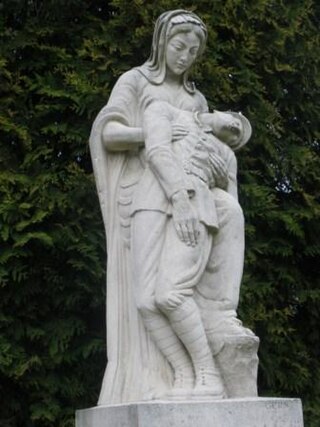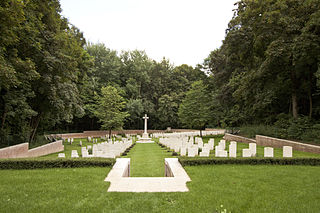
The Battle of the Somme, also known as the Somme offensive, was a major battle of the First World War fought by the armies of the British Empire and the French Third Republic against the German Empire. It took place between 1 July and 18 November 1916 on both sides of the upper reaches of the river Somme in France. The battle was intended to hasten a victory for the Allies. More than three million men fought in the battle, of whom more than one million were either wounded or killed, making it one of the deadliest battles in all of human history.

The 29th Division, known as the Incomparable Division, was an infantry division of the British Army, formed in early 1915 by combining various Regular Army units that had been acting as garrisons around the British Empire. Under the command of Major-General Aylmer Hunter-Weston, the division fought throughout the Gallipoli Campaign, including the original landing at Cape Helles. From 1916 to the end of the war the division fought on the Western Front in Belgium and France.

Hawthorn Ridge Redoubt was a German field fortification, west of the village of Beaumont Hamel on the Somme. The redoubt was built after the end of the Battle of Albert and as French and later British attacks on the Western Front became more formidable, the Germans added fortifications and trench positions near the original lines around Hawthorn Ridge. At 7:20 a.m. on 1 July 1916, the British fired a huge mine beneath the Hawthorn Ridge Redoubt. Sprung ten minutes before zero hour, the mine was one of 19 mines detonated on the first day of the Battle of the Somme. Geoffrey Malins, one of two official war cameramen, filmed the detonation of the mine. The attack on the redoubt by part of the 29th Division of VIII Corps was a costly failure.

The Battle of the Ancre Heights, is the name given to the continuation of British attacks after the Battle of Thiepval Ridge from 26 to 28 September during the Battle of the Somme. The battle was conducted by the Reserve Army from Courcelette near the Albert–Bapaume road, west to Thiepval on Bazentin Ridge. British possession of the heights would deprive the German 1st Army of observation towards Albert to the south-west and give the British observation north over the Ancre valley to the German positions around Beaumont-Hamel, Serre and Beaucourt. The Reserve Army conducted large attacks on 1, 8, 21, 25 October and from 10 to 11 November.

The Battle of the Ancre(13–18 November 1916), was fought by the British Fifth Army, against the German 1st Army. The Reserve Army had been renamed the Fifth Army on 30 October. The battle was the last of the big British attacks of the Battle of the Somme. After the Battle of Flers–Courcelette the Anglo-French armies tried to press their advantage with smaller attacks in quick succession, rather than pausing to regroup and give the Germans time to recover. Subsequent writers gave discrete dates for the Anglo-French battles but there were considerable overlaps and continuities of operations until the weather and supply difficulties in mid-November ended the battle until the new-year.

Beaumont-Hamel is a commune in the Somme department in Hauts-de-France in northern France.

The Beaumont-Hamel Newfoundland Memorial is a memorial site in France dedicated to the commemoration of Dominion of Newfoundland forces members who were killed during World War I. The 74-acre (300,000 m2) preserved battlefield park encompasses the grounds over which the Newfoundland Regiment made their unsuccessful attack on 1 July 1916 during the first day of the Battle of the Somme.

The Capture of Regina Trench was a tactical incident in 1916 during the Battle of the Somme during the First World War. Regina Trench was the Canadian name for a German trench dug along the north-facing slope of a ridge running from north-west of the village of Le Sars, south-westwards to Stuff Redoubt, close to the German fortifications at Thiepval. It was the longest such German trench on the Western Front. Attacked several times by the Canadian Corps during the Battle of the Ancre Heights, the 5th Canadian Brigade of the 2nd Canadian Division briefly controlled a section of the trench on 1 October but was repulsed by counter-attacks of the German Marine Brigade, which had been brought from the Belgian coast. On 8 October, attacks by the 1st Canadian Division and the 3rd Canadian Division on Regina Trench also failed.

The Gueudecourt Memorial is a Dominion of Newfoundland war memorial that commemorates the actions of the Royal Newfoundland Regiment during the Battle of Le Transloy, a sub-battle of the Battle of the Somme of World War I. Located about 1-kilometre (0.62 mi) north-east of Gueudecourt village, the memorial marks the spot where in October 1916, the Royal Newfoundland Regiment played a decisive role in the capture and holding of a German strong-point. The site also marks the furthest point of advance from the July 1st starting line of all British units during the Battle of the Somme.
The 51st (Highland) Division Memorial at Beaumont-Hamel is a memorial in France commemorating the soldiers of the 51st (Highland) Division killed during World War I. The memorial is located near Y Ravine on the 84-acre (340,000 m2) Beaumont-Hamel Newfoundland Memorial site. This position had been the scene of the Division's first major victory on 13 November 1916 during the Battle of the Ancre, the closing stage of the Battle of the Somme.

Hunter's Cemetery is a Commonwealth War Graves Commission burial ground for the dead of World War I situated on the grounds of Beaumont Hamel Newfoundland Memorial Park near the French town of Beaumont-Hamel.

Masnieres British Commonwealth War Graves Commission Cemetery is a small Commonwealth War Graves Commission (CWGC) burial site for British Empire troops killed during the First World War Battle of Cambrai (1918) between September–October 1918. It also contains a number of German graves, although these are mostly unidentified.

Operations on the Ancre took place from 11 January – 13 March 1917, between the British Fifth Army and the German 1st Army, on the Somme front during the First World War. After the Battle of the Ancre, British attacks on the Somme front stopped for the winter. Until early January 1917, both sides were reduced to surviving the rain, snow, fog, mud fields, waterlogged trenches and shell-holes. British preparations for the Battle of Arras, due in the spring of 1917, continued.

On the morning of 1 July 1916, the first day of the Battle of the Somme during World War I, underground explosive charges planted by British tunnelling units were detonated beneath the German front lines. The joint explosion of these mines ranks among the largest artificial non-nuclear explosions.
Serre-lès-Puisieux is a village in the commune of Puisieux in the Pas-de-Calais department in Hauts-de-France in northern France.

The Capture of Beaumont-Hamel was a tactical incident that took place during the Battle of the Somme in the Battle of the Ancre (13–18 November) during the second British attempt to take the village. Beaumont-Hamel is a commune in the Somme department of Picardy in northern France. The village had been attacked on 1 July, the First Day of the Somme. The German 2nd Army defeated the attack, inflicting many British and Newfoundland Regiment casualties.

The Ancre British Cemetery is a cemetery located in the Somme region of France commemorating British and Commonwealth soldiers who fought in the Battle of the Somme in World War I. The cemetery contains mainly those who died on 1 July 1916 during the first Allied attack on the village of Beaumont-Hamel, on 3 September 1916 during the second Allied attack on the village, and on 13 November 1916 during the capture of the village and the nearby towns of Beaucourt-sur-Ancre and St. Pierre-Divion.

The Aveluy Wood Cemetery is a cemetery located in the Somme region of France commemorating British and Commonwealth soldiers who fought in the Battle of the Somme in World War I. The cemetery honors mainly those who died on the front near Aveluy Wood and the village of Aveluy from June 1916 to February 1917 and from April to September 1918.

The Beaumont Hamel British Cemetery is a cemetery located in the Somme region of France commemorating British and Commonwealth soldiers who fought in the Battle of the Somme in World War I. The cemetery contains mainly those who died on 1 July 1916 during the first Allied attack on the village of Beaumont-Hamel and in subsequent operations in the area until February 1917.












